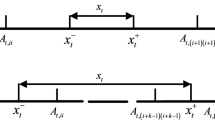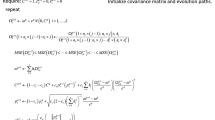Abstract
The combination rule explosion problem of belief rule base (BRB) is a difficult problem to solve in complex systems and has attracted wide attention. A new interval-constructed belief rule base with rule reliability (IBRB-r) is proposed to solve the problem of combination rule explosion in belief rule base. This model not only proposes a new interval rule construction method, but also designs a new interval rule inference process with rule reliability. This approach can not only clearly indicate the contribution degree of each rule to the model, but also solve the problem of combination rule explosion. This is because combining rules in interval addition form avoids the exponential growth in the number of rules caused by combining rules in Cartesian product form. Therefore, IBRB-r is more suitable for complex system modeling. In the case study section, the structural safety assessment of liquid launch vehicle is introduced to conduct a concrete example analysis. Experimental results show that the proposed model achieves over 95% accuracy under the liquid rocket dataset and has relatively higher accuracy under other datasets as well.








Similar content being viewed by others
Data availability
The datasets used in the comparison trial section can be downloaded at the following link: https://aistudio.baidu.com/aistudio/datasetdetail/172847.
References
Cao Y, Zhou ZJ, Hu CH et al (2020) On the interpretability of belief rule-based expert systems[J]. IEEE Trans Fuzzy Syst 29(11):3489–3503. https://doi.org/10.1109/TFUZZ.2020.3024024
Zhou ZJ, Hu GY, Hu CH et al (2021) A survey of belief rule-base expert system[J]. IEEE Trans Syst Man Cybern-Syst 51(8):4944–4958. https://doi.org/10.1109/TSMC.2019.2944893
Chang LL, Xu XJ, Xu ZJ et al (2021) BRB prediction with customized attributes weights and tradeoff analysis for concurrent fault diagnosis[J]. IEEE Syst J 15(1):1179–1190. https://doi.org/10.1109/JSYST.2020.2991161
Zhou ZG, Liu F, Li LL et al (2015) A cooperative belief rule based decision support system for lymph node metastasis diagnosis in gastric cancer[J]. Knowl-Based Syst 85:62–70. https://doi.org/10.1016/j.knosys.2015.04.019
Li GL, Zhou ZJ, Hu CH et al (2019) An optimal safety assessment model for complex systems considering correlation and redundancy[J]. Int J Approx Reason 104:38–56. https://doi.org/10.1016/j.ijar.2018.10.004
Kashem MA, Akhter MN, Ahmed S et al (2011) Face recognition system based on principal component analysis (PCA) with back propagation neural networks (BPNN)[J]. Can J Image Process Comput Vision 2(4):36–45
Ghose DK, Panda SS, Swain PC (2010) Prediction of water table depth in western region, Orissa using BPNN and RBFN neural networks[J]. J Hydrol 394(3–4):296–304. https://doi.org/10.1016/j.jhydrol.2010.09.003
Bardhan A, Samui P, Ghosh K et al (2021) ELM-based adaptive neuro swarm intelligence techniques for predicting the California bearing ratio of soils in soaked conditions[J]. Appl Soft Comput 110:107595. https://doi.org/10.1016/j.asoc.2021.107595
Sun Y, Xu J, Lin G et al (2020) RBF neural network-based supervisor control for maglev vehicles on an elastic track with network time delay[J]. IEEE Trans Indus Inf 18(1):509–519. https://doi.org/10.1109/TII.2020.3032235
Sestino A, Prete MI, Piper L et al (2020) Internet of things and big data as enablers for business digitalization strategies[J]. Technovation 98:102173. https://doi.org/10.1016/j.technovation.2020.102173
Al-Masri E, Kalyanam KR, Batts J et al (2020) Investigating messaging protocols for the Internet of Things (IoT)[J]. IEEE Access 8:94880–94911. https://doi.org/10.1109/ACCESS.2020.2993363
Wu B, Jian H, Gao W, et al (2016) Rule reduction in air combat belief rule base based on fuzzy-rough set[C]. In: International Conference on Information Science & Control Engineering pp 593–596. https://doi.org/10.1109/ICISCE.2016.132
Yang LH, Wang YM, Lan YX et al (2017) A data envelopment analysis (dea)-based method for rule reduction in extended belief-rule-based systems[J]. Knowl-Based Syst 123:174–187. https://doi.org/10.1016/j.knosys.2017.02.021
Li B, Khlif-Bouassida M, Toguyeni A (2020) Reduction rules for diagnosability analysis of complex systems modeled by labeled petri nets[J]. IEEE Trans Autom Sci Eng 17(2):1061–1069. https://doi.org/10.1109/TASE.2019.2933230
Zhang A, Gao F, Yang M et al (2020) A new rule reduction and training method for extended belief rule base based on DBSCAN algorithm[J]. Int J Approx Reason 119:20–39. https://doi.org/10.1016/j.ijar.2019.12.016
Chang LL, Zhou Y, Jiang J et al (2013) Structure learning for belief rule base expert system: a comparative study[J]. Knowl-Based Syst 39(1):159–172. https://doi.org/10.1016/j.knosys.2012.10.016
Yang LH, Ren TY, Ye FF et al (2022) An ensemble extended belief rule base decision model for imbalanced classification problems[J]. Knowl-Based Syst 242:108410. https://doi.org/10.1016/j.knosys.2022.108410
Yang LH, Liu J, Ye FF et al (2022) Highly explainable cumulative belief rule-based system with effective rule-base modeling and inference scheme[J]. Knowl-Based Syst 240:107805. https://doi.org/10.1016/j.knosys.2021.107805
Feng ZC, Zhou ZJ, Hu CH et al (2019) A new belief rule base model with attribute reliability[J]. IEEE Trans Fuzzy Syst 27(5):903–916. https://doi.org/10.1109/TFUZZ.2018.2878196
Yang JB, Liu J, Wang J, et al (2006) Belief Rule-base inference methodology using the evidential reasoning approach–RIMER[J]. In: IEEE Transactions on Systems Man and Cybernetics Part a-Systems and Humans, vol.36, no.2, pp 266–285. https://doi.org/10.1109/TSMCA.2005.851270
Yang LH, Liu J, Wang YM et al (2022) Enhancing extended belief rule-based systems for classification problems using decomposition strategy and overlap function[J]. Int J Mach Learn Cybern 13(3):811–837. https://doi.org/10.1007/s13042-021-01355-z
Yang LH, Liu J, Wang YM et al (2021) Online updating extended belief rule-based system for sensor-based activity recognition[J]. Expert Syst Appl 186:115737. https://doi.org/10.1016/j.eswa.2021.115737
Chang L, Zhang L, Fu C et al (2021) Transparent digital twin for output control using belief rule base[J]. IEEE Trans Cybern 52(10):10364–10378. https://doi.org/10.1109/TCYB.2021.3063285
Yang JB, Liu J, Xu DL et al (2007) Optimization models for training belief-rule-based systems[J]. IEEE Trans Syst Man Cybern Part A Syst Hum 37(4):569–585. https://doi.org/10.1109/TSMCA.2007.897606
Zhou ZJ, Tang SW, Hu CH et al (2021) Evidential reasoning theory and its applications[J]. Acta Autom Sin 47(5):970–984. https://doi.org/10.16383/j.aas.c190676
Feng Z, He W, Zhou Z et al (2020) A new safety assessment method based on belief rule base with attribute reliability[J]. IEEE/CAA J Autom Sin 8(11):1774–1785. https://doi.org/10.1109/JAS.2020.1003399
Afshari M, Mahajan A (2021) Multi-agent estimation and filtering for minimizing team mean-squared error[J]. IEEE Trans Signal Process 69:5206–5221. https://doi.org/10.1109/TSP.2021.3104981
Zhou ZJ, Hu GY, Zhang BC et al (2018) A model for hidden behavior prediction of complex systems based on belief rule base and power set[J]. IEEE Trans Syst Man Cybern-Syst 48(9):1649–1655. https://doi.org/10.1109/TSMC.2017.2665880
Cao Y, Zhou ZJ, Hu CH et al (2021) On the interpretability of belief rule-based expert systems[J]. IEEE Trans Fuzzy Syst 29(11):3489–3503. https://doi.org/10.1109/TFUZZ.2020.3024024
Spettel P, Beyer H, Hellwig M (2019) A covariance matrix self-adaptation evolution strategy for optimization under linear constraints[J]. IEEE Trans Evol Comput 23(3):514–524. https://doi.org/10.1109/TEVC.2018.2871944
Ali J, Saeed M, Tabassam M et al (2019) Controlled showering optimization algorithm: an intelligent tool for decision making in global optimization[J]. Comput Math Organ Theory 25(2):132–164. https://doi.org/10.1007/s10588-019-09293-6
Kundu R, Mukherjee R, Debchoudhury S et al (2013) Improved CMA-ES with memory based directed individual generation for real parameter optimization[C]. Evolut Comput IEEE. https://doi.org/10.1109/CEC.2013.6557643
Hu CH, Feng ZC, Zhou ZJ et al (2020) A safety assessment method for a liquid launch rocket based on the belief rule base with environmental disturbance[J]. J Sci Sin Inf 50(10):1559–1573. https://doi.org/10.1360/SSI-2019-0148
Cui L, Tao Y, Deng J et al (2021) BBO-BPNN and AMPSO-BPNN for multiple-criteria inventory classification[J]. Expert Syst Appl 175(5):114842. https://doi.org/10.1016/j.eswa.2021.114842
Liu LL (2021) Research on digital economy of intelligent emergency risk avoidance in sudden financial disasters based on PSO-BPNN algorithm[J]. Comput Intell Neurosci. https://doi.org/10.1155/2021/7708422
Wang LL, Liang ZC, Pu YR et al (2022) Method for Loran-C additional secondary factor correction based on neural network and transfer learning[J]. IEEE Antennas Wirel Propag Lett 21(2):332–336. https://doi.org/10.1109/LAWP.2021.3131334
Wang G, Wong KW, Lu J (2021) AUC-based extreme learning machines for supervised and semi-supervised imbalanced classification[J]. IEEE Trans Syst Man Cybern Syst 51(12):7919–7930. https://doi.org/10.1109/TSMC.2020.2982226
Chen H, Wang T, Cao J et al (2021) Dynamic quaternion extreme learning machine[J]. IEEE Trans Circuits Syst II Express Briefs 68(8):3012–3016. https://doi.org/10.1109/TCSII.2021.3067014
Deng CW, Han YQ, Zhao BJ (2020) High-performance visual tracking with extreme learning machine framework[J]. IEEE Trans Cybern 50(6):2781–2892. https://doi.org/10.1109/TCYB.2018.2886580
Tan R, Ottewill JR, Thornhill NF (2020) Monitoring statistics and tuning of kernel principal component analysis with radial basis function kernels[J]. IEEE Access 8:198328–198342. https://doi.org/10.1109/ACCESS.2020.3034550
Acknowledgements
Special thanks to my supervisor Mr. He for his careful guidance on this paper. From paper experiment to theory application, Mr. He gave me detailed guidance and spent a lot of energy. Thanks to the journal editors and reviewers for taking the time to review and comment on this paper, which is very helpful to improve the paper.
Funding
This work was supported in part by the Postdoctoral Science Foundation of China under Grant No. 2020M683736, in part by the Teaching reform project of higher education in Heilongjiang Province under Grant Nos. SJGY20210456 and SJGY20210457, in part by the Natural Science Foundation of Heilongjiang Province of China under Grant No. LH2021F038, and in part by the graduate academic innovation project of Harbin Normal University under Grant Nos. HSDSSCX2022-17, HSDSSCX2022-18 and HSDSSCX2022-19.
Author information
Authors and Affiliations
Contributions
Conceptualization was done by XC and WH; methodology was done by XC and WH; validation was done by XC and PH; formal analysis was done by XC; investigation was done by PH; data curation was done by PH; writing—original draft preparation were done by XC; writing review and editing were done by XC and WH; visualization was done by YC; supervision was done by WH and GZ.
Corresponding author
Ethics declarations
Conflict of interest
The authors declare that they have no conflicts of interest.
Ethical approval
This article does not contain any studies with human participants or animals performed by any of the authors.
Consent to participate
Informed consent was not needed, as no humans or animals were involved.
Additional information
Publisher's Note
Springer Nature remains neutral with regard to jurisdictional claims in published maps and institutional affiliations.
Rights and permissions
Springer Nature or its licensor (e.g. a society or other partner) holds exclusive rights to this article under a publishing agreement with the author(s) or other rightsholder(s); author self-archiving of the accepted manuscript version of this article is solely governed by the terms of such publishing agreement and applicable law.
About this article
Cite this article
Cheng, X., Han, P., He, W. et al. A new interval constructed belief rule base with rule reliability. J Supercomput 79, 15835–15867 (2023). https://doi.org/10.1007/s11227-023-05284-2
Accepted:
Published:
Issue Date:
DOI: https://doi.org/10.1007/s11227-023-05284-2




